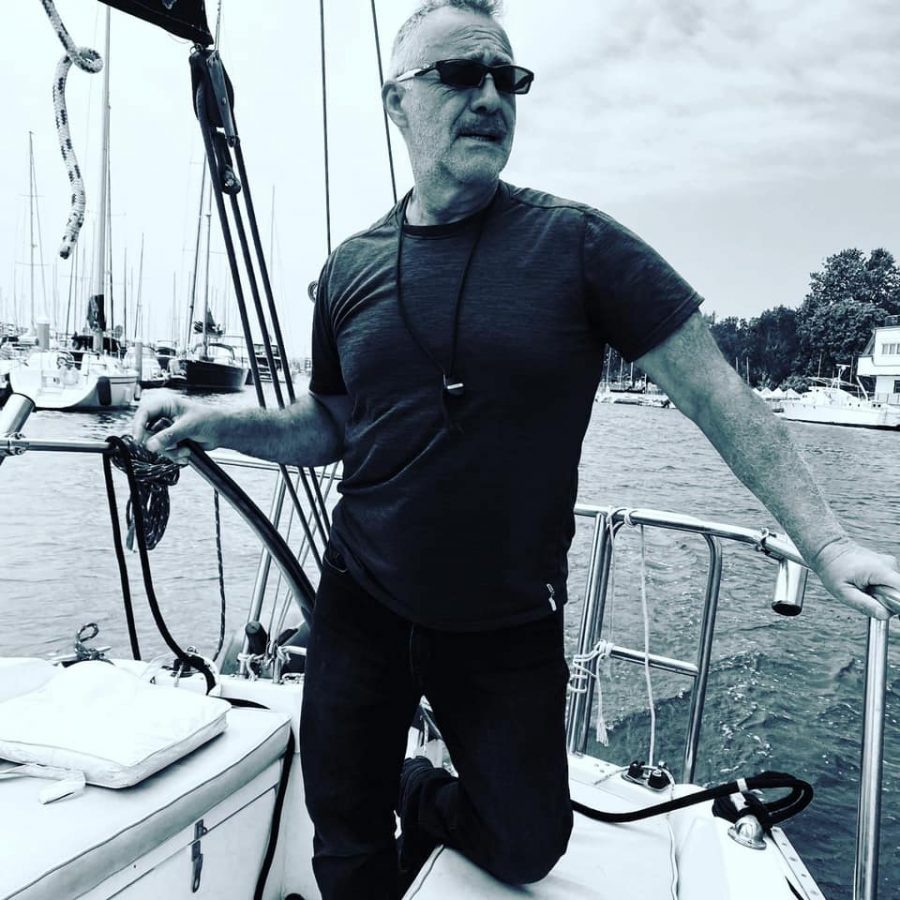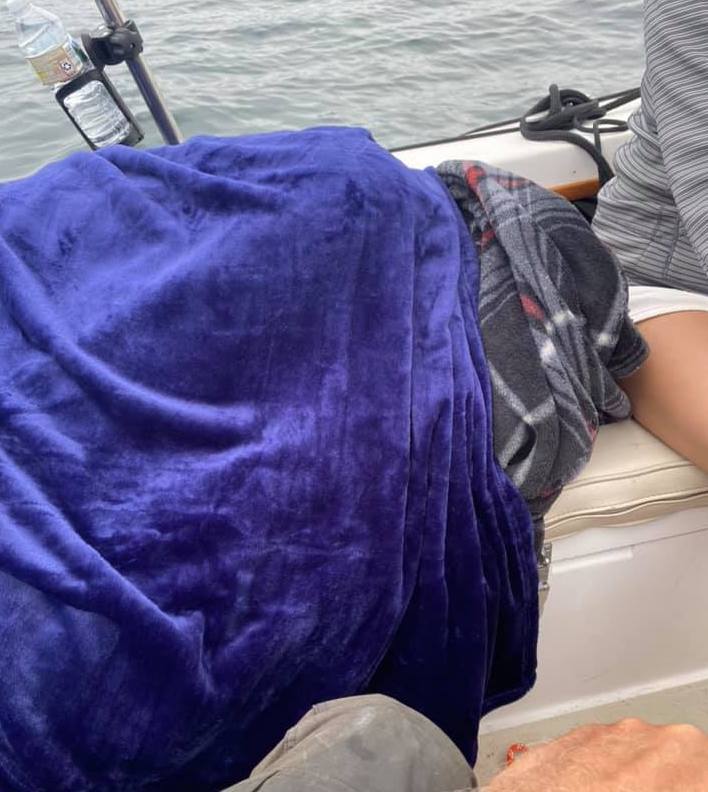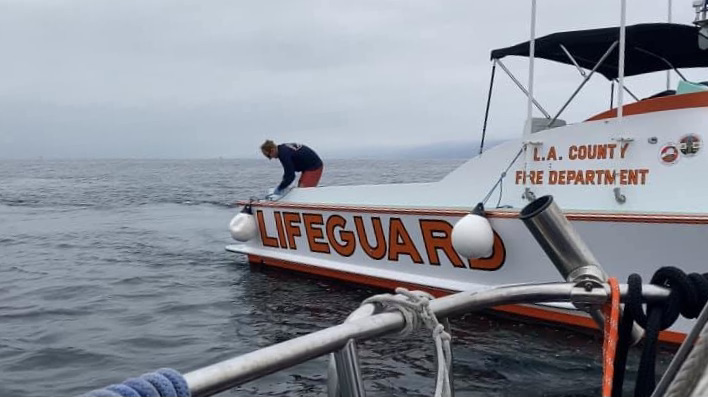
Sailor Performs Ocean Rescue off California Coast
Khosrow Khosravani, from Marina del Rey, had only recently learned to sail when his newly acquired skills were called upon to carry out the rescue of a woman offshore from the Southern California coastline.
“I am still shaking about the horror she faced for 12 hours in darkness in the ocean with no life jacket or anything whatsoever,” Khosrow wrote.
On Sunday September 26, Khosrow was helming his 1982 Catalina 25, Defiant, from Marina del Rey (MDR) to Malibu. This was his “first attempt” to sail outside the harbor aboard the boat he had bought in August. Less than two weeks earlier, on September 14, he had become an ASA (American Sailing Association) Certified Sailor after completing ASA 101 and103.

Khosrow had three guests onboard, none of whom were sailors. During the coming rescue they would each play a role in bringing the distressed woman onto the boat.
“I noticed her thanks to a pod of dolphins.” Khosrow and his guests were watching the dolphins when they saw a hand waving. “She had no life jacket, and was just treading water.”
It would later appear that the woman had gone for a swim alone, at almost midnight on Saturday. Due to some unknown difficulty she was unable to return to shore and was found the next morning, a few miles offshore.
“She is a true fighter, who defied the odds and survived in the cold water,” Khosrow said.
Khosrow added that once Defiant‘s crew had the woman onboard they issued a Mayday call. “[She was] barely conscious but could tell us that she was alone and that I did not have to look for other survivors in the vicinity.”

“We covered her with a warm blanket and gave her water. Then within 10 minutes or less, the Coast Guard sent a rescue boat. The young lady survived and is in stable condition at Ronald Reagan Hospital at UCLA. Praying for her well-being … And thanks to my three guests on the boat for staying calm and following my rescue instructions. Buying this cheap sailboat was a blessing.”

Khosrow said that according to local authorities, it is quite common for young people in the area to swim off the beach late at night.
We’ll share the full story of the rescue in an upcoming issue of Latitude 38. In the meantime, Khosrow’s last words on the subject: “Stay safe. Life is so precious.”

Outstanding outcome from a gentlemen that took time to take a couple of lessons to be better prepared to sail his boat, which turned out saving a life!
Great story and valiant successful effort!! Thank you and thank you for sharing !
Absolutely essential for all boat owners to learn how to do MOB rescue amd then practice it! ASA or US Sailing classes are great!
Wow. How lucky was this woman in so many fortuitous ways?! What a story.
Incredible story….. Lives changed forever……Life is precious…..
For hypothermic persons have them snuggle up with spare humans under blanket(s). Any amount of ADDED heat is better than none.
Blankets will not warm a hypothermia victim. Stripping the persons clothing and having another body with skin to skin contact works. This woman is double lucky.
Great story.
Sailors rock!
(Especially after that story of a sexual assault on a train the other day where the bystanders did nothing…not even call 911).
Lucky woman.
One of the best investments I made at the beginning of my sailing adventures (re: safety, competence, confidence) was to take the ASA sailing classes.
Wow! Terrific outcome! Hypothermia is a big topic that just underwent some new developments. A few words of caution about hypothermia treatment and heat application…
Those that are hypothermic are at risk of ‘afterdrop’. In cold conditions, the body shunts warm blood centrally to the core to keep the core temperature warm. The periphery (arms and legs) began to harbor supercooled blood. Lots of activity, vigorous movements of the patient by the rescuer, and applied heat to the extremities can actually make matters worse by increasing circulation of this supercooled blood centrally, and subsequently dropping the core temperature even further after the victim has been rescued, dried, etc
Thus, it is important to handle the hypothermic victims with care, lay them down, and, as pointed out, strip and dry the victim before applying blankets or (big) spooning the victim.
IF you are going to apply heat packs, make sure to heat from “the inside out”- i.e with heat applied to the core over the heart, or as close to it as possible- armpits, central back. The core gets warmed first (as opposed to throwing someone into a hot tub or putting warm packs on their hands and feet) to avoid afterdrop and other life threatening issues. Chemical heat packs for hands and feet are not recommended, as the heat can be too isolated, and intense. Avoid burning the patient with applied heat.
Dr. Gordon Giesbrecht, aka Dr. Popsicle who collaborated with US Sailing on the Safety at Sea curriculum, has a great podcast episode describing the science behind rewarming: https://luminarypodcasts.com/listen/wem-live/wilderness-&-environmental-medicine-live/march-2019-wilderness-&-environmental-medicine-live/21ac107b-3fc6-4504-a1dc-fa43dae52293?country=US
Enjoy!
Wow! What an amazing story. And thank you Mr. Taussig for the important information about how to address hypothermia.
Thank you for all your comments and feedback. The young lady was already nude so the two guest ladies on my boat dried her with towel (very gently) and then warmed her with the blanket. At this point, I knew that the rescue boat was just minutes away so I did not think of any body to body warmth transfer as suggested. But that is great information for me to know for future cases. The primary challenge was bringing the lady with no muscle functionality from the ocean surface to the cockpit (dead weight) and if I was alone that day, it would have been super challenging. Well, quite an education on my first “voyage” outside the safe harbor!